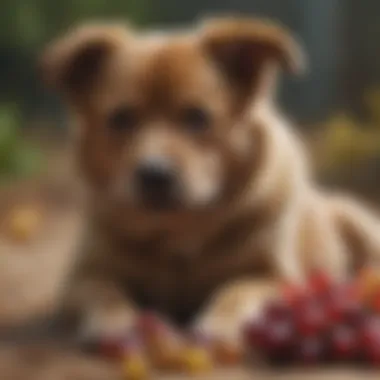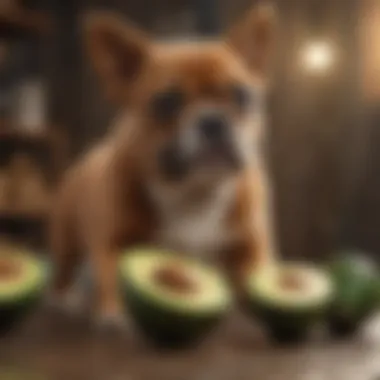Foods That Can Harm Your Dog: What to Avoid


Intro
Feeding a dog is a complex task. Many people are unsure about what their pets should or should not eat. While dogs may have a penchant for human food, not all of it is safe. Understanding which foods are harmful to dogs can play a crucial role in their health and longevity. As a responsible pet owner, knowing which items to avoid ensures that you protect your canine companion from serious health risks.
Pet Care Essentials
Daily Nutrition Requirements
Canines have specific dietary needs. A balanced diet typically includes protein, carbohydrates, fats, vitamins, and minerals. However, alongside these needs, it's vital to prioritize safe food sources. This research can help form a streak of nutritious habits from the onset. Knowledge about ingredient safety empowers pet owners to provide the best possible sustenance while simultaneously dodging potential hazards. Each dog, depending on age, weight, and breed, will have varying nutritional needs.
Exercise and Playtime
Your dog's overall well-being extends well beyond the bowl. Regular exercise improves not just physical fitness but also mental tiredness. Appropriate outlets for energy reduce the instances of behavioral issues, leading to a more harmonious household. Mixing exercise with safe and appropriate rewarding food for dogs remains imperative.
Health and Wellness Check-ins
Routine veterinary visits prove beneficial in monitoring your dog's health. Vaccinations, dental care, and testing can preempt numerous ailments. Keeping an eye on your ongoing pet's condition complements proper feeding practices significantly. Just as nutrition is vital, attentiveness towards overall pet wellness creates a strong foundation.
Grooming Tips
Regular grooming helps maintain a healthy coat. Tasks like brushing, bathing when needed, and nail trims contribute to overall health. Clean fur combats allergens and promotes better skin health. Utilizing proper grooming products is essential, and feeding appropriate food enhances skin texture and coat health as well.
Foods to Avoid
- Chocolate
Dark chocolate, especially, contains compounds toxic to dogs. The symptoms can vary from restlessness to seizures. - Grapes and Raisins
These may cause acute kidney failure. Even small amounts can be hazardous. - Xylitol
Found in many sugar-free products, it may lead to insulin release and resultant hypoglycemia. - Onions and Garlic
These can cause hemolytic anemia, a serious condition affecting red blood cells. Be especially cautious of these in prepared foods.
Always consult with a veterinarian regarding dietary decisions for your dog. The right advice can mitigate risks you might overlook.
Prolusion to Canine Nutrition
Canine nutrition is foundational to ensuring the health and longevity of dogs. A well-balanced diet has the power to significantly improve the quality of life for dogs. The focus is not just on what dogs should eat, but equally on what they cannot consume. Feeding a dog inappropriate foods can lead to severe health complications. This article therefore emphasizes safe practices in canine dietary habits, advising pet owners to make informed decisions regarding their fur companions.
Understanding the Canine Digestive System
Dogs have a distinct digestive system, which processes food quite differently from humans. Their gastrointestinal tract is shorter, tailored for a diet rich in protein and fat and low in carbohydrates. The rapid digestion is facilitated by higher levels of stomach acid. This characteristic makes many human foods harmful to dogs, highlighting the importance of knowing the limitations of their diet.
To start, the mouth is where digestion begins. Dogs rely on their teeth to tear and chew food, which is aided by saliva. Nevertheless, chewing is only part of the process. Then food progresses to the stomach, an acidic environment where proteins break down. This is where foods like chocolate or grapes can have detrimental effects due to their toxic compounds.
Finally, food moves through the intestines, where nutrients are absorbed into the bloodstream. From this perspective, it is clear that certain foodstuffs, which may seem harmless or even beneficial to humans, can wreak havoc on a dog's system.
Importance of Proper Nutrition for Dogs


Proper nutrition cannot be overstated in its significance for dog health. Just like humans, dogs require a balanced intake of carbohydrates, proteins, fats, vitamins, and minerals. A balanced diet strengthens their immune system, maintains a healthy weight, and supports overall well-being. Choosing the right food lays the groundwork for a dog’s physical condition and temperament.
Moreover, a nutritious diet plays a crucial role in preventing chronic diseases that could severely impact a dog’s life. For instance, certain foods can trigger allergic reactions or exacerbate pre-existing conditions. Each dog also possesses specific dietary needs depending on factors like age, size, and breed. Therefore, an understanding of proper nutrition fosters happier, healthier pets. If dog owners can grasp the nuances of their dog's needs, they can make more suitable food choices that align with their pets' health requirements.
Common Human Foods Dangerous for Dogs
Common human foods can present significant risks to canine health. Understanding what to avoid is crucial for dog owners. This section emphasizes the necessity to identify foods that can be toxic or harmful to dogs. By recognizing these dangers, pet owners can minimize risks and promote the well-being of their pets. Education about these foods allows for informed feeding practices that prioritize a dog's health.
Chocolate
Chocolate is notorious for being hazardous to dogs. It contains theobromine and caffeine, substances that dogs metabolize slowly. Even small amounts can lead to severe health issues. Consuming chocolate can cause symptoms like vomiting, frequent urination, and increased heart rate. In severe cases, it might even lead to seizures or death. Dark chocolate and baking chocolate have higher levels of theobromine, making them especially dangerous. Therefore, it is essential to keep any chocolate products securely out of reach.
Grapes and Raisins
Grapes and raisins have been linked to acute kidney failure in dogs. Research shows that even a small quantity may lead to these serious health issues. The exact substance causing the toxicity remains unidentified, making them particularly unpredictable regarding effects. Dogs that consume grapes or raisins may exhibit symptoms such as vomiting, diarrhea, and lethargy. If you suspect your dog ingested these fruits, it is vital to act quickly by consulting a veterinarian.
Onions and Garlic
Onions and garlic are commonly used in many kitchens but should never be given to dogs. They contain compounds that can be toxic and lead to oxidative damage in dog blood cells, potentially resulting in anemia. Symptoms may include weakness, lethargy, and digestion-related upset. Simply feeding cooked or raw onions and garlic can pose dangers. Owners must be diligent not only when feeding but also when preparing meals that could potentially involve these ingredients.
Avocado
Avocado contains a substance called persin, which can be harmful to dogs. While it might be safe in very small amounts for some pets, the risk is significant enough to warrant caution. Dogs can experience gastrointestinal upset after consuming avocado. Items such as guacamole may contain additional harmful ingredients like onions or spices, compounding the risk. To ensure safety, it’s best to avoid feeding avocado to dogs altogether.
Alcohol
It is widely understood that alcohol is toxic to dogs. Intoxication may lead to significantly reduced coordination, slowed respiration, and in severe cases, can be fatal. The potential for severe health consequences makes it imperative for pet owners to ensure their dog does not have access to any alcoholic beverages. Any exposure, even small amounts, can be dangerous, and veterinary intervention may be necessary.
Caffeine
Caffeine should be treated similarly to chocolate when it comes to dogs. It contains theobromine, leading to potential harm. Dogs that ingest caffeine can show symptoms like restlessness, rapid heart rate, and nausea. While ingestion of a small amount may not cause severe harm, it’s again safest to assume that any caffeine should be kept away from dogs. Common sources include coffee, tea, and energy drinks, all of which pose a danger.
Macadamia Nuts
Researchers have classified macadamia nuts as harmful to dogs, but the pathway of toxicity remains unclear. Symptoms such as lethargy, tremors, and elevated temperatures have been documented post-consumption. This specific nut seems to be particularly harmful in doses varying by size and metabolism of individual dogs. It is prudent to avoid giving dogs these nuts in any form.
Xylitol
Xylitol, a sugar substitute often found in gum and baked goods, is extremely dangerous for dogs. It can cause insulin spikes that result in dangerously low blood sugar levels. Symptoms like vomiting, lack of coordination, and seizures can occur. Due to the widespread presence of xylitol in consumer products, pet owners must be vigilant and check ingredient lists carefully before sharing anything with their dogs. Immediate vet assistance may be necessary if ingestion is suspected.
Other Foods to Be Cautious About


Understanding what foods are harmful to dogs is crucial for pet owners. While some items are well-known hazards, others may surprise you. The topic of other foods to be cautious about provides more depth to canine dietary considerations. Importantly, food items that might seem harmless can have severe effects on dogs. Awareness of these risks ensures that dogs remain healthy and happy.
Keeping dogs away from certain human foods avoids potential health problems. The negative outcomes can include gastrointestinal distress, pancreatitis, or even poisoning. Feeding a dog safe and suitable food not only responds to their direct health needs but also establishes a trusting relationship with pet owners.
Dairy Products
Dairy products often appear innocent. However, many dogs display lactose intolerance, leading to various health troubles when consumed. Most adult dogs digest dairy poorly. This condition can cause stomach upset, diarrhea, and flatulence. It is a common misconception that dogs can enjoy products like cheese or ice cream without consequences. Therefore, caution with dairy consumption is wise for keeping your dog in good health.
Fatty Foods
Fatty foods present significant risks to canine health. High-fat content can quickly lead to pancreatitis, a seriously painful condition for dogs. Foods such as bacon and greasy leftovers should be avoided. While dogs can sometimes handle small amounts of fat, excessive quantities disrupt their digestive processes. This is why moderation is vital. Monitoring their diet will prevent potential sudden health issues related to high-fat consumption.
Raw Eggs
The consumption of raw eggs harbors potential risks for dogs. One prominent issue includes the threat of salmonella or E. coli infection. Despite the occasional claims of raw egg benefits, these risks should discourage feeding them to dogs. Additionally, raw egg whites can inhibit biotin absorption. This deficiency may lead to skin and coat problems in dogs. It is better to explore safer, cooked alternatives for their nutrition needs.
Cooked Bones
Cooked bones pose a danger to dogs that is often overlooked. When the bones are cooked, they become brittle and can splinter during chewing. These sharp pieces can cause serious injuries to a dog's digestive tract. This injuriess can even require emergency medical intervention in severe cases. Virtually all veterinary recommendations advise against giving cooked bones, urging owners to prefer safer chewing options instead, such as specially designed chew toys.
Certain Seafood
Seafood can be a dicey option when it comes to dog diets. Some types of seafood, such as shrimp, can lead to allergic reactions in certain canines. Raw fish may also house harmful parasites leading to more severe problems, like vomiting and diarrhea. If fish is to be included in a dog's diet, it should be cooked and handled very carefully. That minimizes any detrimental effects. Owners should highlight both the source and pattern of introducing seafood to their pets.
Signs of Food Intolerance or Poisoning
The ability to recognize signs of food intolerance or poisoning in dogs is vital for all pet owners. Knowledge is power when it comes to understanding what can hurt our canine companions. This section delves into the symptoms you might observe when your dog ingests harmful substances, as well as the actions you should immediately take to ensure their safety.
Recognizing Symptoms
Identifying the signs that indicate your dog has consumed something harmful can be challenging. Symptoms may vary based on the specific food involved, and each dog's response can differ. However, here are some common indicators of food intolerance or poisoning:
- Vomiting: A frequent symptom that can arise quite quickley.
- Diarrhea: Loose stools might occur, signaling that the dog's digestive system is upset.
- Lethargy: If your dog is less active than usual, it may point to discomfort.
- Loss of Appetite: Ignoring food can be a direct response to feeling unwell.
- Excessive Drooling: Often linked to nausea, drooling may increase when being poisoned.
- Restlessness or Anxiety: Signs of unease such as pacing may surface.
These manifestations can arise promptly after ingestion, in some cases within minutes, or may appear a few hours later. Being observant can help you act promptly.
Seeking Immediate Veterinary Care
When it comes to instances of possible food poisoning, a quick response is critical. Should any symptoms appear, its best to contact a vet immediatley. Take these steps to ensure your dog receives appropriate care:
- Call your veterinarian: Describe the symptoms and the type of food your dog ingested. Follow any specific instructions they may provide.
- Have pertinent details ready: Information about your dog’s size, age, breed, and health conditions may assist the vet in making accurate recommendations.
- Monitor symptoms: Keep a close eye on any unusual behavior or changes in your dog’s condition, and report these to your veterinarian.
- Emergency care: In serious cases, converting any symptoms into emergency veterinary care should happen. Urgency can mean the difference between a sped recovery or furthercomlicated issues.


"Act quickly, as every second counts when managing potential food poisoning."
With any potential sign, procuring professional assistance is always safest. Knowledge of these symptoms can drastically reduce risks and save a furry friend from side effects that might occur from their food choices.
Safety Tips for Pet Owners
Ensuring the safety of pets is a primary responsibility for any dog owner. Dogs rely on their owners to provide them with a safe environment and suitable nutrition. Certain foods can pose serious health risks, which makes it crucial to have strategies in place to protect them from harmful substance ingestion. This section outlines important safety measures pet owners should adopt to mitigate risks and enhance their dog's well-being.
Creating a Dog-Friendly Kitchen
A dog-friendly kitchen is a crucial informaiton for preventing accidents related to food consumption. Pet owners should routinely assess their kitchen environments. Keeping harmful foods out of reach is essential. Consider the following points for a secure kitchen:
- Storing Food Securely: Store human food in high cabinets or using child-proof locks. Avoid placing food on kitchen counters.
- Proper Disposal: Make sure trash bins are pet-proof. Accidental access to scrap can lead to ingestion of dangerous items.
- Clean Floors: Clean up food debris or spills quickly. Dogs are prone to investigating fallen food, which might include hazardous items.
Having a soup or pasta heating up can be tempting for a dog. Use hard-to-tip containers and lids, or they might make their way to an unattended meal as quick as possible.
Educating Family and Friends
In addition to creating a safe kitchen, educating family and friends is significant. When sharing space with a pet, all individuals involved must understand foods that are unsafe for dogs. Here's how to promote a safer environment:
- Inform Visitors: Explain which foods are harmful. Visitors can accidently feed your dog something they believe is safe. Transparency aids prevention.
- Arrange Adaptable Gatherings: When hosting events, keep dog access restricted from areas with food. Have a separate place for the dog away from celebrations.
- Use Informational Material: Posters or flyers outlining safe and unsafe foods can be distributed to busy families. This education reinforces critical knowledge.
Effective communication fosters awareness. Simple discussions can prevent tragic mishaps, ensuring your dog's health remains robust.
Alternatives to Dangerous Foods
Identifying alternatives to harmful foods connect with safeguarding pet interests. Healthy substitutes are available, which can benefit your dog's diet effectively. Here are common available substitutes for risk-filled human foods:
- Pumpkin: As a good source of fiber and vitamins, cooked and plain pumpkin can replace poor choices. Avoid spiced pumpkin products - they are unsafe.
- Carrots: These are low-calorie snacks that promote rhythms. Serving in complexity may gentle the healthy snack.
- Peanut Butter: In moderation, natural peanut butler is safe partake. Avoid brands containing xylitol.
- Fruit: Many fruits are suitable during moderation, like blueberries or apple slices minus the seeds.
This advice encourages pet owners to give dogs healthier options without compromising safety. Proper understanding results in enjoyable, nutritious alternatives to potential hazards that could lead to defing healthult issues.
Culmination
In this article, the critical subject of food safety for dogs has been discussed at length. Mandatory knowledge of what foods not to feed dogs is essential for all pet owners. Just like us, dogs require appropriate nutrition to maintain health and well-being. However, several human foods, while safe or even healthy for humans, can pose significant risks for dogs. By summing up key takeaways from the points discussed, potential hazards can be better understood and mitigated.
Summarizing Key Takeaways
- Dark Chocolate, Grapes, and Onions: These common food items can lead to severe health issues, from kidney failure to poisoning. Always keep them out of reach.
- Fatty Foods and Cooked Bones: Such items can lead to gastrointestinal distress in dogs. Dogs have different digestive processes than humans, making them more susceptible to these issues.
- Dangerous Artificial Sweeteners: Products containing xylitol are harmful and can cause a rapid drop in blood sugar levels. This emphasizes the need for cautious consumption.
- Education and Awareness: By understanding these dangers and learning about food safety, pet owners fulfill their responsibility in ensuring the well-being of their pets.
Encouraging Responsible Feeding Practices
Promoting responsible feeding practices is paramount in preventing health issues arising from pantry surprises. Consider adopting these practices:
- Research Before Sharing: Any human food intended for sharing should be well-researched. Look for reputable sources, including your veterinarian's recommendations.
- Meal Replacement Ideas: Instead of trying to feed them table scraps, consider dog-friendly snacks, such as carrots, apples, or specialized dog treats. Keeping meals balanced is vital.
- Secure Storage: Store dangerous foods well out of reach of pets. A simple maneuver like safeguarding the kitchen can save lives.
Remember: A little knowledge can go a long way. Learn about appropriate canine diets.
Responsible feeding not only supports a healthier lifestyle but enriches the bond between owner and pet. Knowledge leads to informed choices, paving the way for a long and healthy relationship with your furry companion.







